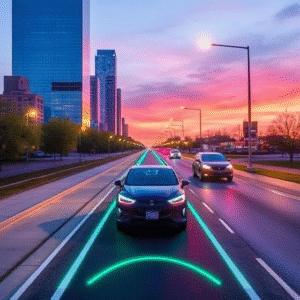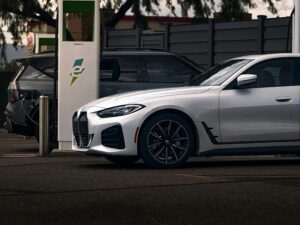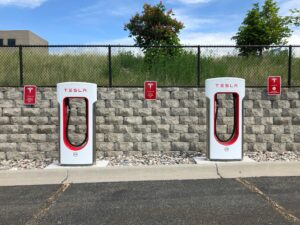
Wireless Charging Roads: The Future Where EVs Never Need to Plug In
Detroit has made history by installing America’s first wireless electric road, enabling EVs to charge while driving. However, with installation costs reaching nearly $2 million per mile, serious questions remain about whether this technology can become a practical transportation solution
At first glance, it looks like any ordinary city street. But along Detroit’s 14th Street, something revolutionary is happening beneath the asphalt. This unassuming quarter-mile stretch in Corktown represents America’s first public road capable of charging electric vehicles as they drive – no plugs required.
The secret lies beneath the surface. Engineers have installed electromagnetic coils connected to the city’s power grid, creating an invisible charging zone. Using inductive charging technology (similar to wireless phone chargers), these coils generate an electromagnetic field that transfers energy directly to specially equipped EVs through receivers mounted on their undersides.
This pilot project aims to tackle one of the biggest obstacles to EV adoption: range anxiety. With charging stations still scarce and charging times lengthy, many drivers remain hesitant to abandon gasoline vehicles. A network of such “electric roads” could continuously top up vehicle batteries during commutes or long trips, potentially eliminating the need for traditional charging stops altogether.
Stefan Tongur, VP of Business Development at Electreon, compares this shift to the evolution of mobile phones: “Just as we moved from charging cables to wireless power for smartphones, we’re now bringing that convenience to electric vehicles,” he explained during an interview at CES in Las Vegas. “The future is roads that charge your car as you drive and park.”
While still in its early stages, this technology could redefine how we power our vehicles. But significant challenges remain – including the high cost of installation and the need for widespread vehicle compatibility. For now, Detroit’s innovative stretch of road offers a glimpse into what might one day become the new normal for transportation.

Wireless Charging Roads: A Glimpse Into the Future of EV Infrastructure
Electreon, a pioneer in wireless charging technology, is testing its innovative system across strategic locations in Europe, Asia, and North America. Last November, the company made history by embedding magnetic induction coils beneath a quarter-mile stretch of Detroit’s 14th Street—marking America’s first public roadway capable of charging electric vehicles on the move.
A Collaborative Vision for Sustainable Mobility
The $1.9 million pilot project, co-funded by the Michigan Department of Transportation and Electreon, aims to expand this “smart road” to a full mile within the next few years. This initiative aligns with Michigan Governor Gretchen Whitmer’s ambitious plan to achieve carbon neutrality by 2050. A key component of this strategy involves building a robust EV charging network by 2030, including wireless charging roads and 100,000 traditional chargers to support an anticipated 2 million electric vehicles statewide.
“Detroit, the historic heart of the automotive industry, is the perfect place to lead this mobility revolution,” says Justine Johnson, Michigan’s Chief Mobility Officer.
The Scalability Challenge
Despite its promise, the technology faces skepticism due to its steep costs—currently nearing $2 million per mile. Experts like Ashley Nunes, a behavioral economics researcher at Harvard Law School, argue that widespread adoption may be financially impractical.
However, Electreon remains optimistic. Stefan Tongur, the company’s VP of Business Development, anticipates costs will drop as the technology evolves, potentially reaching 1.2millionpermile∗∗withreceiverunitspricedaround∗∗1,000 each.
Strategic Deployment Over Mass Adoption
Rather than blanketing entire cities with charging roads, Electreon is focusing on high-traffic transit corridors—particularly routes used by commercial fleets like buses and delivery trucks. These vehicles follow predictable schedules, making them ideal candidates for dynamic charging that minimizes downtime.
“The goal isn’t to deploy this everywhere,” Tongur explains. “It’s about targeting areas where the business case is strongest—where continuous charging maximizes efficiency and cost savings.”
The Road Ahead
While questions about affordability linger, Detroit’s pilot project represents a bold step toward reimagining EV infrastructure. If successful, wireless charging roads could eliminate range anxiety, reduce charging downtime, and accelerate the transition to electric mobility—proving that the future of transportation might just be lying beneath our wheels.
New research suggests that installing 155-186 miles (250-300km) of electric charging roads along major freight corridors could eliminate over 200,000 tonnes of CO₂ emissions annually from heavy trucks. This innovative approach would allow electric and hybrid lorries to charge while driving, dramatically reducing their reliance on fossil fuels and cutting operational downtime for charging stops.

Wireless Charging Roads: The Smart Solution for Cleaner Trucking and Public Transit
Experts agree that wireless charging roads could be a game-changer for medium and heavy-duty trucks—vehicles responsible for disproportionately high carbon emissions per mile.
Why Trucking is the Perfect Fit
- Fixed routes make freight corridors ideal for targeted installation
- 35kW charging per receiver (100kW for trucks with 3 receivers)
- Extends range in charging “deserts” where stations are scarce
- Swedish studies show 155-186 miles (250-300km) of electric roads could cut 200,000+ tonnes of CO₂ annually from trucks
The Business Model: Charging-as-a-Service
Electreon is pioneering a subscription model (800−1000/month) for fleets like buses and delivery trucks. Their CaaS (Charging-as-a-Service) platform is already operational in Israel through a $9.4M partnership with Tel Aviv’s Dan Bus Company (200 buses).
Europe Charges Ahead: How 10,000+ Miles of Electric Roads Will Reshape Transportation
Europe is leading the global charge in electric road systems (ERS), with ambitious plans that could transform long-distance travel:
National Road Electrification Projects
- France: Committed to 5,500 miles (8,850km) of electrified roads by 2035
- Germany: Studies recommend 2,500 miles (4,000km) on Autobahns
- Sweden: Budgeting $2.9-3.8B for 1,200 miles (2,000km)
(Source: National transport ministries)
How It Works: Three Competing Technologies
- Overhead Cables (Sweden/Germany) – Pantograph-equipped trucks
- Conductive Rails (France trials) – In-road metal contacts
- Inductive Charging (Electreon) – Buried electromagnetic coils
Global Expansion: Electreon’s Wireless Charging Pilots
✔ German Autobahn: First wireless charging testbed for trucks
✔ Utah State University: NSF-funded research roadway
✔ Pennsylvania Turnpike: Bid submitted for electrification
Why This Matters for EV Adoption
- Municipalities can install coils during routine road maintenance
- Automakers could reduce battery sizes by 30-50% (lowering EV costs)
- Fleets gain uninterrupted operation with dynamic charging
The Auto Industry’s Wireless Charging Race
| Company | Partner | Tech Focus |
|---|---|---|
| Toyota | Electreon | Passenger vehicles |
| BMW/Ford | Witricity | Luxury EVs |
| Stellantis | Hevo Power | Commercial fleets |
| Tesla | (In-house) | Proprietary solution |
US Government Backing
The Biden Administration’s $7.5B NEVI/CFI programs could fund wireless charging corridors as part of:
- 500,000 public chargers by 2030
- National highway electrification initiatives
“This isn’t just about range anxiety—it’s about creating reliable, seamless charging ecosystems,” says Michigan’s Justine Johnson.
Key Takeaways for Policymakers & Investors:
▸ Europe’s 10,000+ mile commitment sets global precedent
▸ Three competing technologies create market opportunities
▸ Wireless charging reduces battery costs (critical for mass adoption)
▸ US funding programs now include dynamic charging solutions
Want more innovation insights?